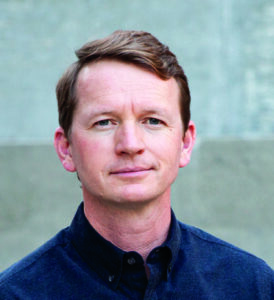Andrew Malick ’00
 Degrees: B.A. in engineering; master’s in architecture, master’s in urban design, Washington University in St. Louis; master’s in real estate development (for architects), Woodbury University
Degrees: B.A. in engineering; master’s in architecture, master’s in urban design, Washington University in St. Louis; master’s in real estate development (for architects), Woodbury University
Job Title: Founder and CEO of Malick Infill Development in San Diego, founded in 2015
Favorite Trinity Memory: My senior year, all of the engineering students were grouped into teams and tasked to create a device that could allow a human to walk on water. Each team then had to compete against each other side by side in the pool to determine the most effective device. I was elected to be the pilot of my team’s machine. It was the best test of what we learned in the engineering school. A way to apply mathematics and engineering principles into an, albeit ridiculous, real-world application. It was challenging and really fun. Thanks, Dr. Peattie.
Why did you found your company? I did not have ambitions to become a real estate developer. After Trinity, I worked for a corporate general contractor building high-rise office buildings. Construction was exciting, but I became bored with it after five years. I decided to study urban design because there was a growing body of research that correlated our postwar land development patterns with many social ills. Public health problems like obesity and depression were tied to suburbanization but so too was climate change.
I didn’t know how I wanted to use my degree, but land-use planning and design seemed a very interesting and fulfilling area of study. My timing was terrible. When I finished my degree, it was 2009. The market had crashed, and there weren’t any design jobs. Construction had halted in San Diego much like everywhere else, but there were a select few who had figured how to build during the downturn. This group claimed the common moniker of architect-developer. After learning more about the scene, I saw that these architects hadn’t merely figured out a formula to build when no others were but they also were doing really different and precedent-setting projects. In effect, they were implementing the good urban design principles I’d studied in school, but they didn’t have to convince a developer of their progressive ideas to implement them because they were the developer.
I worked for a couple of these architect-developers before being encouraged to start my own firm. My first project was won by competition. The municipality that hosted the competition was looking for a catalyst project to revitalize a dying main street. Our solution was titled “downtown in one building,” and the ideas in it were the culmination of everything I had learned to date. I used to cringe when people referred to me as a developer. Our society has a notoriously poor opinion of the profession. But recently I’ve tried to embrace the title and explain the difference between what I do as an infill developer. We try to balance social equity, environmental responsibility, and economic viability. The infill developer is the good developer.
What do you do in your role? Since the founding of my company, I’ve split my time pretty equally between advocating for better land-use policy and running a boutique development company. I knew going in that 70 years of jumbled legislation had effectively made multifamily housing illegal, so policy work was essential to carving a place for my business to exist. Fortunately, as suburban housing was becoming more difficult to build because of strict environmental laws and the threats of wildfire, policymakers were eager to find new ways to solve our extreme lack of housing.
What do you enjoy most about your work? I get to design and develop really cool places for people.
What are the biggest challenges you face? Skilled-labor shortages in the construction industry. We have talent shortages in all rungs of the ladder from upper management to laborer. If we are going to keep up with housing demand, we’re either going to need to figure out how to do it with fewer people or encourage more to work construction jobs.
How did Trinity prepare you for the work you do now? The Engineering Department taught me problem-solving skills, my athletics coaches taught me that self-improvement requires hard work, and The Accidentals, a student-run a cappella group, honed my teamwork skills.
What was the most memorable course you took at Trinity? “Calculus II.” It was so memorable, I took it twice.
Was there a professor at Trinity who was particularly influential? The late Miller Brown was very influential. He taught me in an intro to philosophy course, but more than that he taught me how to reason. After receiving a bad grade on my first paper, I visited him during his office hours to seek help. He was so kind and patient. The methods he taught me I still use to this day.
